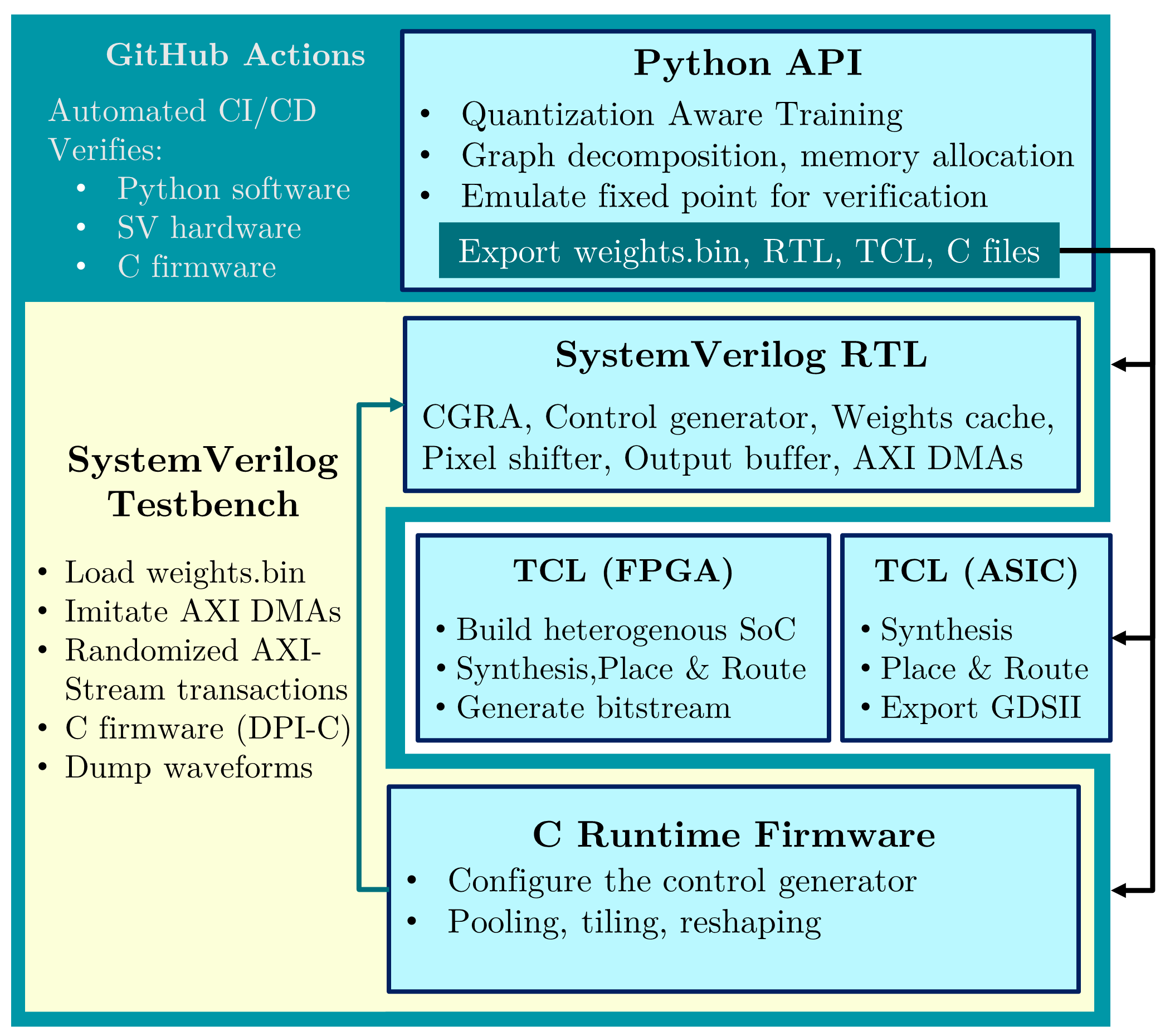cgra4ml is a Python library that helps researchers build, train, and implement their own deep ML models, such as ResNet CNNs, Autoencoders, and Transformers on FPGAs and custom ASIC.
It takes a lot of effort and expertise to implement highly optimized neural networks on edge platforms. The challenging aspects include:
- Designing an optimal dataflow architecture
- Building & verifying an accelerator, optimizing for high-frequency
- Building the System-on-Chip, verifying and optimizing data bottlenecks
- Writing C firmware to control the accelerator and verify its correctness
Often, after all that work, the models do not meet their expected performance due to memory bottlenecks and sub-optimal hardware implementation.
We present a highly flexible, high-performance accelerator system that can be adjusted to your needs through a simple Python API. The framework is maintained as open source, allowing a user to modify the processing element to their desired data type using customized architecture, easily expand the architecture to meet the desired performance, and implement new neural network models.
#define NDEBUG
#include "platform.h"
#include "deepsocflow_xilinx.h"
int main() {
hardware_setup();
xil_printf("Welcome to DeepSoCFlow!\n Store weights, biases & inputs at: %p; \n", &mem.w);
model_setup();
model_run(); // run model and measure time
// Print: outputs & measured time
Xil_DCacheFlushRange((INTPTR)&mem.y, sizeof(mem.y)); // force transfer to DDR, starting addr & length
for (int i=0; i<O_WORDS; i++)
printf("y[%d]: %f \n", i, (float)mem.y[i]);
printf("Done inference! time taken: %.5f ms \n", 1000.0*(float)(time_end-time_start)/COUNTS_PER_SECOND);
hardware_cleanup();
return 0;
}HLS4ML is an open source python framework that's being widely adopted by the scientific community, to generate FPGA & ASIC implementations of their custom Deep Neural Networks. CERN has taped out chips with DNN compression algorithms to be used in LHC using HLS4ML. However, it is not possible to implement deeper neural networks on HLS4ML since it implements one engine per layer in hardware. This project aims to solve that problem and enhance HLS4ML, by creating a statically & dynamically reconfigurable, AXI-Stream DNN engine.
-
You need either Verilator 5.014+ or XIlinx Vivado for simulation
-
Clone this repo and install deepsocflow
git clone https://github.com/KastnerRG/cgra4ml
cd cgra4ml
pip install .- Run the example
# Edit SIM and SIM_PATH in the file to match your simulator
cd run/work
python ../example.py- FPGA implementation:
3.1. Generate Bitstream from Vivado:
# Make sure correct fpga board was specified in the above script. Default is ZCU102
# Open Xilinx Vivado, cd into deepsocflow, and type the following in TCL console
cd run/work
source vivado_flow.tcl3.2. Run on a ZYNQ FPGA:
- Open Xilinx Vitis
- Create an application project, using
.xsagenerated by running therun/work/vivado_flow.tcl - Right click on application project -> Properties
- ARM v8 gcc compiler -> Directories -> Add Include Paths: Add absolute paths of
run/workanddeepsocflow/c - ARM v8 gcc compiler -> Optimization -> Optimization most (-O3)
- ARM v8 gcc linker -> Libraries -> Add Library:
m(math library)
- ARM v8 gcc compiler -> Directories -> Add Include Paths: Add absolute paths of
- Build, Connect board & launch debug
- Add a breakpoint at
model_setup(). When breakpoint hits, loadrun/work/vectors/wbx.binto the address printed. - Continue - This will run the model and print outputs & execution time
- ASIC implementation with Cadence Genus & Innovus:
# First add your PDK to 'asic/pdk', change paths in the scripts and run:
cd run/work
genus -f ../../tcl/asic/run_genus.tcl
innovus
source ../../tcl/asic/pnr.tcl- Aba
- Zhenghua

